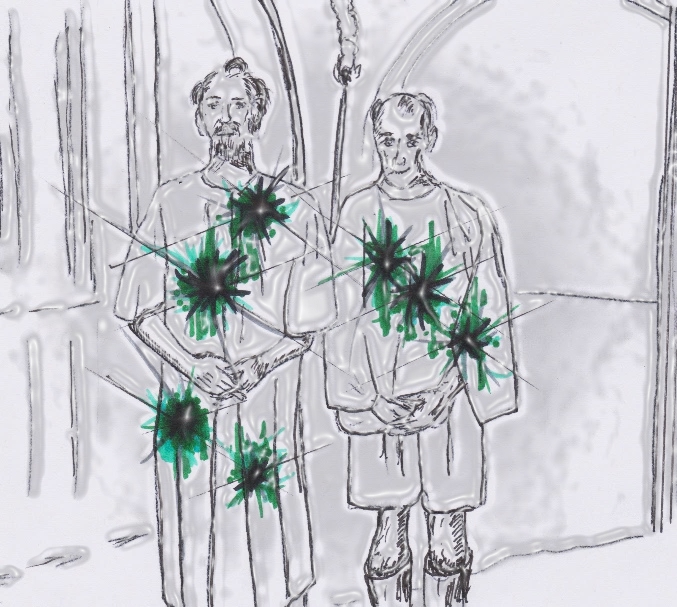Two members of Organia’s High Council from the
Star Trek
episode Errand of Mercy, changing from humanoid form (which was adopted for the sake of visitors), to their true form of pure energy. (Illustrations by the author.)
Man’s destiny in the medium term will, hopefully, involve development and beneficial utilisation of many of the mechanisms and systems outlined in this book. The actual mechanical performance of machines has, for some time, meant that they are capable of quite impressive physical feats. But this is in theory – in practice there have been severe limitations in our ability to write programs that enable them to operate automatically in useful ways. The world is a very complex place and things naturally become disordered with the passage of time. Up to now, robotic devices have found it extremely difficult to adapt to variations caused by this natural disorder – to the extent that it is often cheaper to do a given task manually than to order the environment sufficiently for it to be achieved by the current generation of robots. But all of this is changing due to recent developments in AI and particularly deep learning – which was discussed in some detail in earlier sections. We are currently just on the cusp of a robotics revolution that will change our lives in many ways for the better – I don’t think this is an exaggeration. By this I don’t mean we will have androids like Star Trek
’s Data walking around within the next 5 or 10 years. Rather, we will have robots that will look more like the current versions of robots and automation we see in today’s automated factory lines. The difference is that the future generations of robots and systems will be able to accommodate the variations and randomness we encounter in the real world – and still be able to get useful tasks completed
. It cannot be long, surely, before robot systems start to tackle large percentages of the dangerous, difficult and dirty tasks that civilisation demands to be completed and which, up to now, have been the hard lot of those worthy citizens who have volunteered over the years to undertake them. I believe that many of us would welcome this. In the medium term, such robotic devices in combination with the replicator technologies alluded to earlier, are bound to be able to provide for just about all our material needs. In this situation, what is left for mankind? A tremendous amount, as it happens; for we would then all be able to devote much of our time to leisure activities or spiritual pursuits that we currently frequently say that we wish we had time for. If we are being honest, we would have to say (like Pink Floyd): “Have; have not, and who’ll deny it’s
what the fighting’s all about?” If money had little to no value due to the fact that we had virtually anything we needed or wished for, then for sure there would be much less incentive for squabbling over money on the local scale or starting devastating wars internationally. Imagine being able to live a very comfortable life and having no concerns more pressing than how to balance your time between composing music or writing poetry. Or your interests might be somewhat less fine art – you may simply get the most spiritual satisfaction from bicycle rides in the countryside – or anything else that you fancied. Such could be our destiny – if we do not allow ourselves in the meantime to be consumed by greed and fear. Gene Roddenberry had the foresight to appreciate this – which is why it is clear in his creations such as Star Trek: The Next Generation
(STNG), that money does not feature in his positive vision of the future. By the way, I don’t see why, eventually, it should not be possible to build androids/robots with advanced capabilities and performances similar to those of Data in STNG, but as for whether such devices will ever comprise sentient beings, well, that is quite another matter.
Having said a few things about potentialities for the medium term, what then can we say about mankind’s longer-term destiny? Well, it’s very much up to us – we can waste more and more time and effort on weapons of mass destruction that can never be used (for if they were our destiny would be very clear and very shameful). Either we can continue to ‘blow it’, so that mankind’s rule on this speck of dust floating in the cosmos comes to a premature and ignominious termination, or we can look to the future with hope. The latter is what we need to do to ensure the long-term survival of the species as well as our cultures and achievements. These have, after all, certainly been very hard won over the millennia, and surely the last thing we wish to do would be to throw them away for no good reason.
So, how can we survive? As mentioned above, our future is not recorded in the stars, but I would say that the stars hold the key
for our future, so they are what we must reach for in the long term. In many ways, the whole of this book is aimed at making some
observations that might provide some indications of how we might go about doing this. More specifically, the above few sections of the text address some relevant practical considerations – such as whether and how we might travel fast enough to reach the stars. Such questions are, I feel, very important to the whole book – so much so that I feel it is worth ending this section by giving a brief summary of what we have found in this area.
 Reach for the stars
Reach for the stars
REACH FOR THE STARS – the kind of poster you might expect to see in a nursery or primary school – but the message is just as important for us adults
.
(Photograph by Ali Abdul Rahman, courtesy of Unsplash, used with permission.)
Modern astronomy has identified many potentially inhabitable planets orbiting stars in the Milky Way Galaxy; however, exploration of these exoplanets requires travel over great distances (numerous
light years). Traditional interpretations of special relativity have concluded that human travellers cannot attain the speed of light (c) and that approaching c causes time dilation, so that a traveller returning to Earth would find everyone significantly aged. Consequently, interstellar travel has been assumed to be impossible within a human lifetime. The above sections have re-assessed the implications of the two postulates of special relativity; and if the conclusions are correct, would indicate that a traveller might, in fact, greatly exceed c relative to Earth and return without having aged excessively due to time dilation effects. If this were possible, return travel to nearby stars and their exoplanets would be attainable, with conceivable technological developments, and within attainable periods (years but not decades or centuries). Such exploration would clearly be of extreme scientific value and a potentially revolutionary event in human history. It would have very profound implications for both our understanding of mankind’s place in the cosmos and also the ultimate destiny of humanity. In short, it would help to move us along the road that leads to our being able to answer those questions that our young children ask of us so earnestly but which we find ourselves unable to answer in any way that could be considered satisfactory.
“The Cosmos is all that is or was or ever will be. Our feeblest contemplations of the Cosmos stir us -- there is a tingling in the spine, a catch in the voice, a faint sensation, as if a distant memory, of falling from a height. We know we are approaching the greatest of mysteries.”
― Carl Sagan, Cosmos
Who knows whether faster than light speed will ever be attained, thereby making interstellar travel a practical prospect? At the moment, at least for me, it is hard to be certain; you will also have an opinion and only time and further experimental data will tell us for sure. If it could be attained in the not too distant future, this would provide extremely strong motivators for continuing research and development of high-speed space travel. Such a capability might offer humanity a means of ensuring survival in the very long term, even in the event of possible long-term environmental degradation
or catastrophes on the Earth
.




 Reach for the stars
Reach for the stars